[This post is essentially reprinted from an article I wrote for the December 2016 Buoy Tender, the newsletter of the Marker Buoy Dive Club. As a newsletter article, it has a little more boat review than I’d typically do in this space. Feel free to scroll down to the pretty pictures.]

I’ve heard of the storied Truth Aquatics fleet out of Santa Barbara for years, and my November 2016 trip to the Channel Islands on the Vision was my initiation.

The Vision anchored in the kelp off of Santa Cruz Island.
When I signed up for the trip, I knew the sleeping arrangements were not separate staterooms and the risk of being nightly at the mercy of a snoring chorus was high. I’ve been on a lot of different types of boats, and I had never shared one giant sleeping room with everyone on the boat before, ever. So I was a bit reluctant. But having been diving in the Channel Islands in 2008, I very much wanted to return. I packed noise-canceling headphones and filled my i-devices with music to sleep by.
The boat felt like one giant floating dive platform. And who wouldn’t like that? The back deck (the dive deck) was large. I should disclose that we had fewer divers on this charter than normal, so I know that luxury contributed to the spaciousness everywhere – on the dive deck, in the galley, and in the sleeping room. But even with guaranteed more divers, I will go back. That’s how much I enjoyed it.
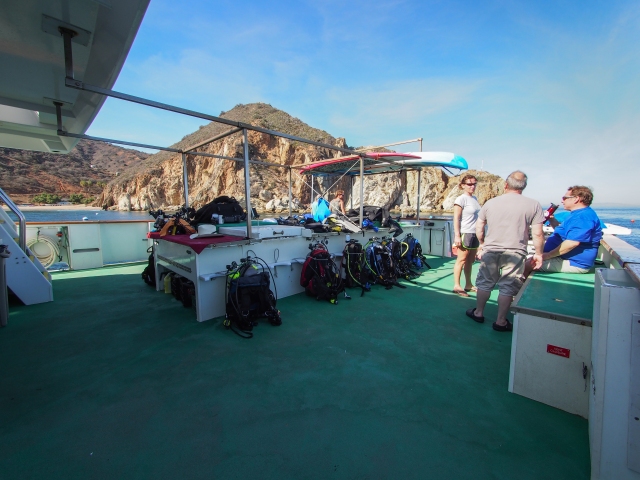
The large dive deck of the Vision.
In terms of sleeping, the online map of sleeping quarters makes it look like one big awful room with and endless sea of depressing, skimpy sleeping pallets. That’s not what it’s like at all. The area is U-shaped with bunks along the walls, and each bunk has wood partitioning, lights, and thick curtains – and the double beds are massive – so when you are in your bunk, it’s very private, and I found it to be cozy and comfortable (aided, perhaps, by the flannel sheets I brought with me – you do bring your own sheets). I didn’t just tolerate it – I actively enjoyed it. And bonus – no snorers! I didn’t even need the headphones.
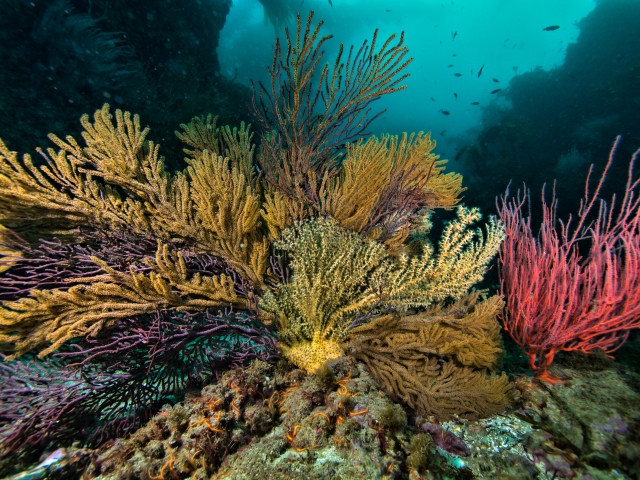
California golden gorgonians, some with yellow zoanthids growing on them in the foreground, brittle stars all over the bottom, and red gorgonians on the right.
I signed up for the trip through Anacortes Diving, and they had booked Richard Salas, a professional underwater photographer, to give photo workshops. Richard gave us daily lectures combined with live demonstrations to illustrate his points. He also gave us assignments – thorough, meaningful, helpful, and fun assignments. Richard was enthusiastic and engaging – he never tired of our questions, of talking about photography, nor of inquiring about our experiences, and he never tired of trying to help us improve. He was generous with his time (to a fault) because he is insanely passionate about this stuff. It made everyone else excited too.
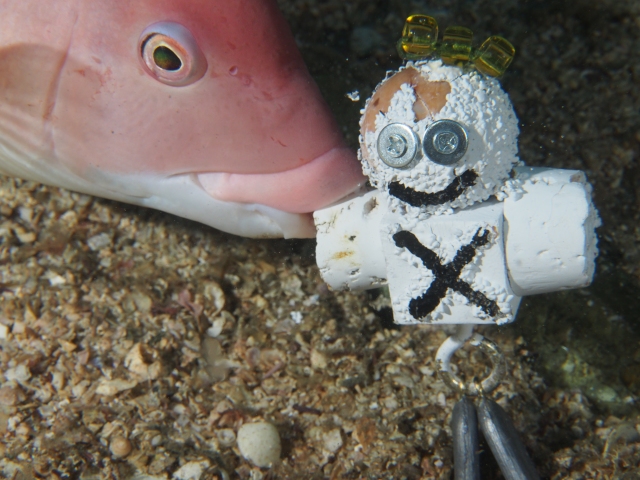
Kerbals underwater! Richard made a little army of these guys for us to take in the water and practice our photo lessons. The female sheephead (pictured) and senioritas kept trying to eat mine.
Our first day was spent at Santa Cruz Island, then we headed to the oil rigs just off-shore from LA. That night we headed to Catalina, where we spent a couple days. Next up was Santa Barbara Island, where we had two delightful dives with the California sea lions. Then one more day at Santa Cruz Island before heading in. Six days diving with opportunities for about 25 dives total (I did 22). And we were never rushed to get in the water – with the exception of the oil rigs, you could take your time getting in and stay in the water as long as you liked. I loved this unusual format.

Dive platforms Ellen and Elly. We did one dive on each.
Richard’s lessons centered around lighting – strobe placement – and how to bring more life and dimension into our photos. It forced you to prepare for a specific shot, rather than just aiming and shooting at everything you swim by (which is how I normally, er, previously behaved). Of course it’s great when a fish actually cooperates once you have your lighting all set for some coral.
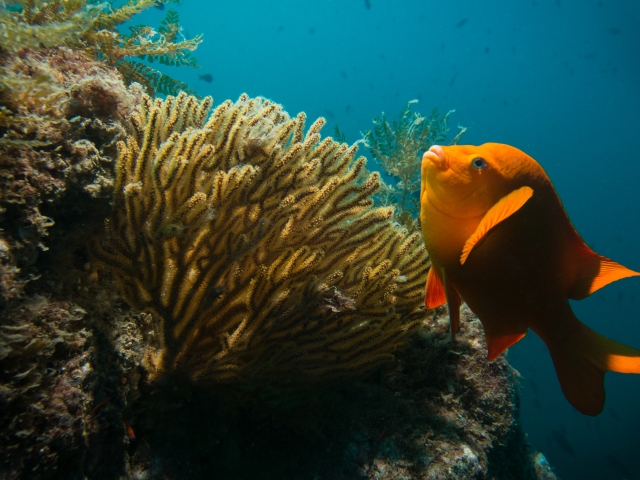
Garibaldi with California golden gorgonian at Catalina Island.
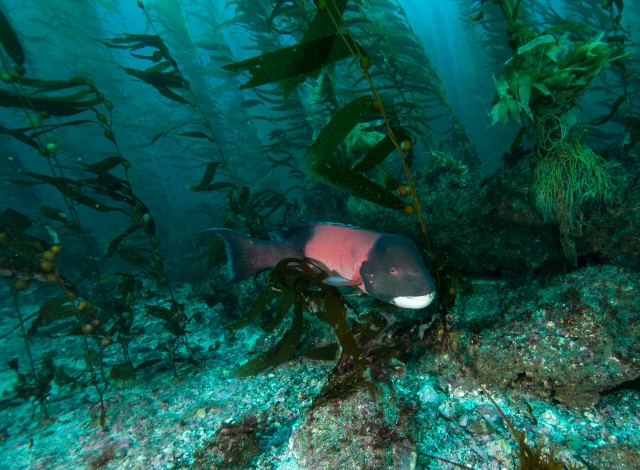
Male sheephead and Macrocystis kelp at Santa Barbara Island.
Richard convinced me to not worry about backscatter, at least not yet. Unleash your inner backscatter? Why not. But then when my backscatter got totally out of control and you could sometimes even see my strobes in the photos, he taught me how to dial it back just a little bit.
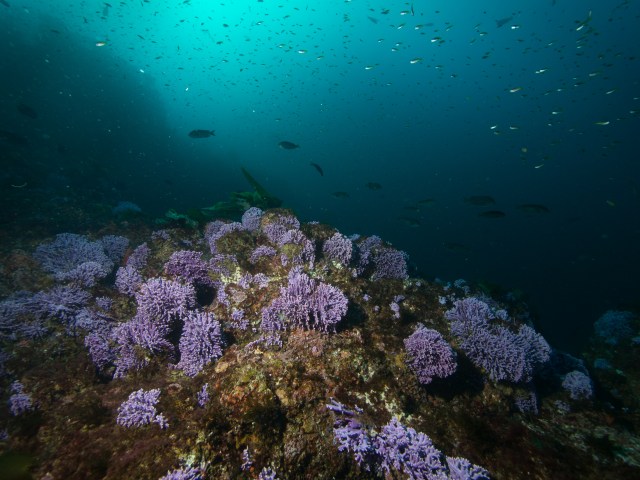
Acres of purple hydrocoral at Farnsworth Bank. The backscatter transforms into fish in this shot.
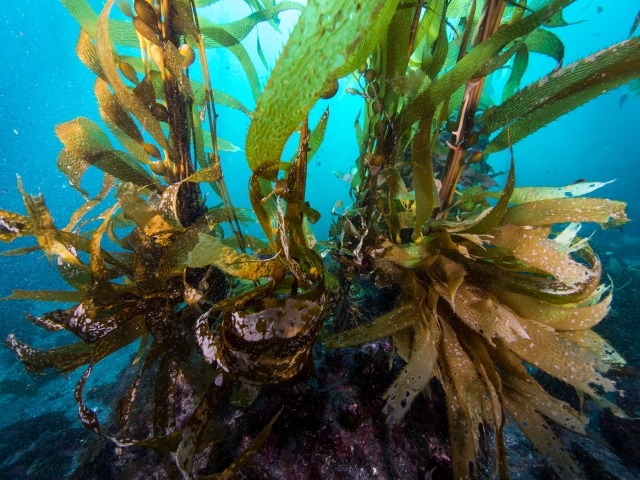
Down at the hold-fasts, Santa Barbara Island.
I used wide angle nearly the entire trip. That itself was a lesson to me, as I am so much more comfortable with macro. Breaking out of the camera comfort zone in California.
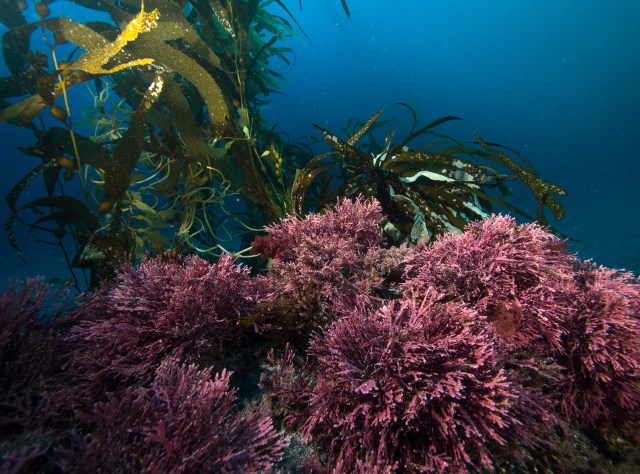
Red coralline algae, Santa Barbara Island.
Richard also helped us with ambient light. We were instructed on getting the ambient light set correctly before even turning on the strobes. The only time that’s a bummer is when you drop in and there is a sea lion immediately staring you in the face, and the instinct to snap produces a silhouette at best – but with great ambient light no doubt.

Red gorgonian on our final day, Santa Cruz Island.
I was happy to take my standard lens on a few dives, especially when encountering one of the local octopus or horned sharks.
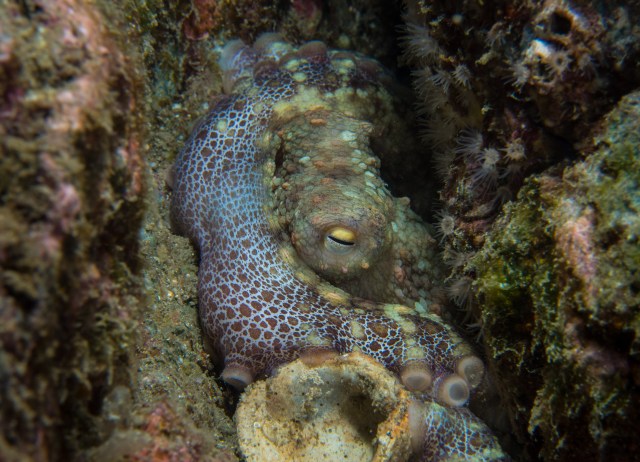
California two-spot octopus at Catalina. We saw several of these octos during the week.
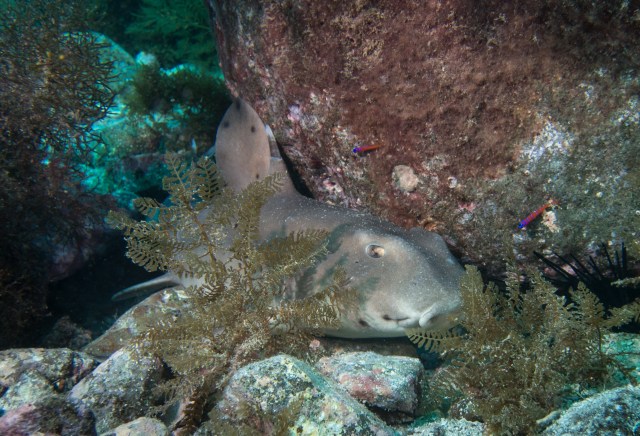
Horned shark at Catalina Island.
Although it was November, we had unseasonably delightful weather and calm seas. Everyone wore shorts and t-shirts, and we never had to shut the galley door that leads to the dive deck all week long. Skies were mostly clear, which is great in kelp forests. Water temps ranged mostly in the low to mid 60s, though on a couple dives at Santa Cruz it got all the way down to 55. But I remained comfortable using no gloves the whole trip.
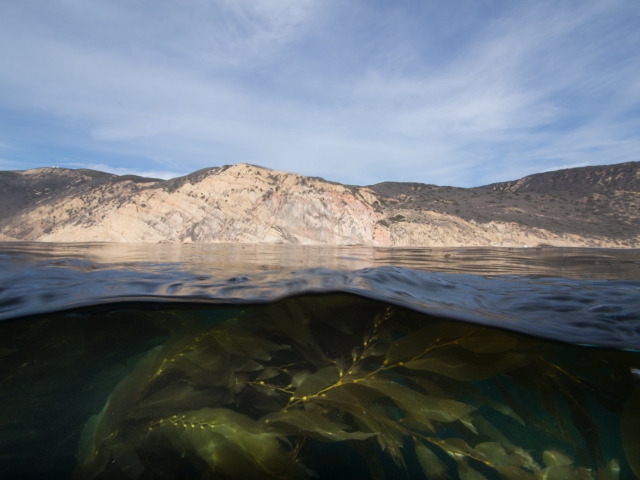
Sun, good viz, and beautiful kelp at Santa Cruz Island.
One rather unexpected phenomena occurred our second night on the boat. The crew had dropped a light in the water, and dozens of squat lobster came to the surface and floated around. But what was even stranger was their butts seemed to give off sparks! Yes, I said that. Their butts gave off sparks.
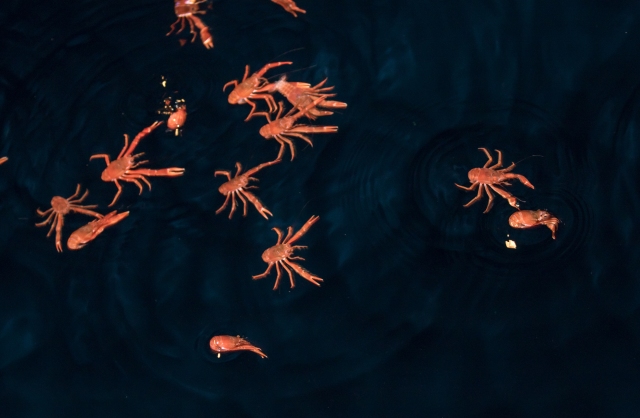
Squat lobsters at the surface after dark. The things that look like gunk in the water were actually some sort of sparks flying out of their bodies.
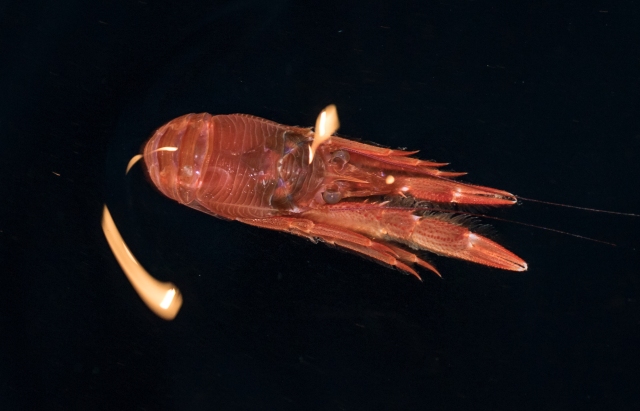
Close-up of one of the squat lobsters. The sparks seemed to emanate from their butts.
One of the final photo lessons was about aiming your strobes to light up only what you wish to illuminate. This is tricky, but it is possible. I managed to successfully bring out the details in some very black sea hares while not washing out their very white egg masses. It’s a good thing giant sea slugs don’t have eyes, because there would be a lot of blind sea hares at Santa Cruz after my stubborn efforts. Anyway, the photos below are not sea hares. But I got a million great sea hare photos if anyone would like to see them. Just let me know.
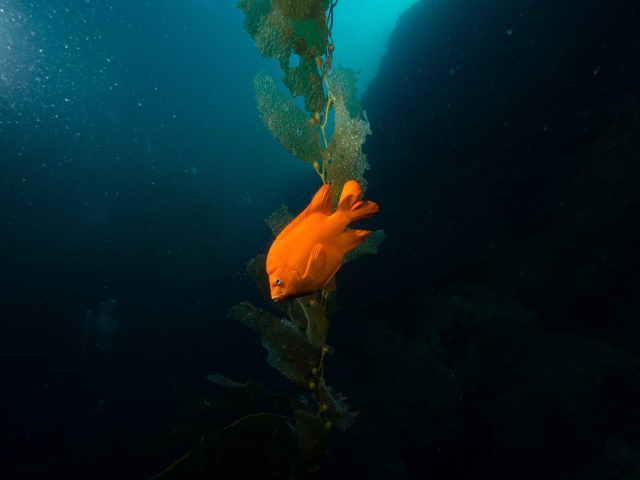
Garibaldi at Catalina Island.
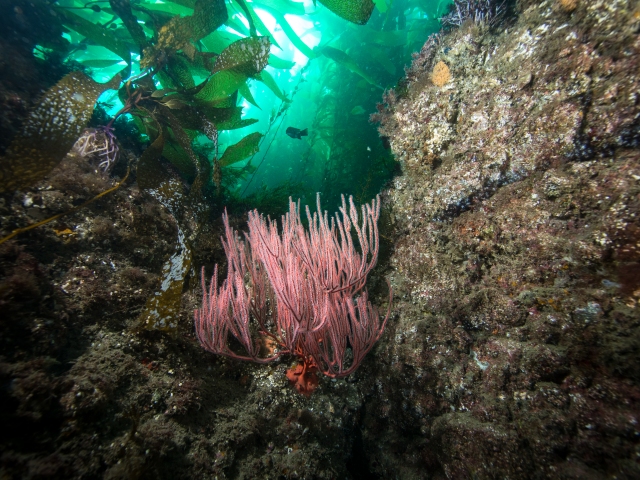
Red gorgonian with Macrocystis kelp at Santa Cruz Island.
The trip felt like a floating classroom; each dive a study session. It didn’t have to be that way, but I embraced it. Though in terms of academic placement, I was in first grade. AP first grade at best. But as with most adults going back to school, I’m excited to learn and improve. Back here at home in Puget Sound, I am excited to get out as much as I can to keep practicing what we learned. Old subjects just became new again.

great pictures !! very fun trip !!!
Thanks, Tom!